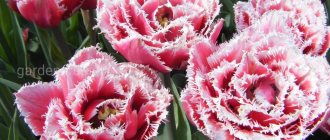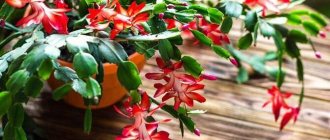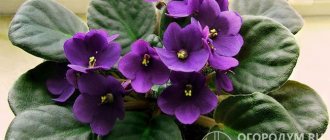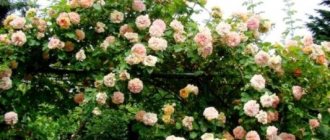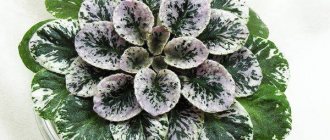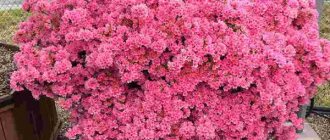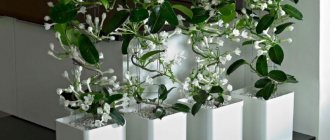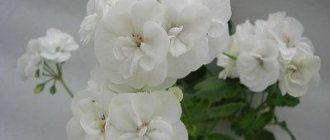Hibiscus Terry is a beautiful and undemanding plant that lives for a long time and delights with its bright color. The overseas guest has long since taken root in Russia. It can grow in the form of a tree, shrub or herbaceous crop. Sometimes trees grow up to one and a half meters in height. And the grassy representatives rise slightly above the ground.
Terry hibiscus (Hibiscus terry) is also called Chinese rose.
Botanical description, history, geography of distribution
The plant dates back to ancient times. The cultivation of terry hibiscus began already in the 18th century. Through step-by-step selection, the plant acquired the appearance and properties that it has now. Maximum decorativeness and unpretentiousness.
The plant is native to the southern regions of China. Wild specimens of terry hibiscus can be found there, as the plant is extremely heat-loving. It is also found in the subtropics and tropics.
The cultivated version of terry hibiscus, obtained by breeders, is intended mainly for home cultivation. Only in regions with a very mild climate is it possible to plant the plant in open ground.
An evergreen plant with oval-shaped leaves with small teeth along the edges. The foliage has a rich green color. The flowers can reach 25 cm in diameter and have different colors: pink, red, pale orange and yellow.
Double hibiscus flowers consist of several rows of petals, creating a multi-layered effect. It is this feature that makes the plant highly decorative. The lifespan of each individual flower is only a day, but new buds bloom daily. Blooms for a long time - from early spring to late autumn. If all care conditions are met, you can achieve year-round flowering.
Origin and appearance
The birthplace of the flower is considered to be China, Southeast Asia and Polynesia. In natural conditions, the plant is an evergreen shrub or tree, reaching 5 meters. At home they grow Chinese hibiscus - this is also a bush or tree, but it can grow in indoor conditions only up to 2-3 meters.
Garden hibiscus
Its leaves are a little like birch leaves: they have teeth along the edge, a smooth sparkling corrugated surface of a dark green color, and an elongated oval shape.
The inflorescences are single, funnel-shaped, and at the moment of full opening can reach 12-14 cm in diameter; in the middle there is a pistil, which can look like an elephant’s trunk. Depending on the variety, they come in different colors: white, yellow, red, pink and others.
Note! The lifespan of each flower is very limited: they fall off after 1-2 days, but in favorable conditions the buds constantly replace each other from spring to autumn.
Varieties and varieties
Garden hibiscus has another name - Street. It includes mainly the Syrian species, but other varieties are also grown in practice.
Syriac is originally from China. This is a shrub with green, ovoid leaves ten centimeters long, in the wild it reaches five meters in height. Its varieties come in different shades - pink, white, orange.
Trifoliate hibiscus is native to North Africa, as this area has a less arid climate than the northern or central regions. Today it is actively grown in all areas with good watering of the land. It has a taproot system, a straight stem up to eighty centimeters. Its leaves are petiolate, tripartite, pubescent, and have a diameter of no more than two centimeters. The flowers are yellow with a red center and grow up to four centimeters.
The peculiarity of the variety is that the flowers open early in the morning for a couple of hours, after which they immediately close.
The hybrid species grows in the wild. But it also feels great in the garden. This specimen appeared after crossing several species from North America, namely: Holly, Swamp and Red hibiscus.
People have always considered it a plant of misfortune that brings bad news and death. But this superstition applies to the Chinese rose or Chinese hibiscus.
Syrian and Hybrid hibiscus are not dangerous. They are readily grown in gardens and at home. The flower is revered among gardeners and just amateurs, because it does not require much attention, grows very quickly and blooms beautifully.
Hawaiian and herbaceous hibiscus
Hawaiian hibiscus - the name says it all - is grown in Hawaii. It is a shrub up to a meter high. The leaves are elliptical, concave. The flowers, like other hibiscus specimens, are large, bright red. Hibiscus is herbaceous - can reach a height of two and a half meters.
The colors of the flowers are very diverse - white, pink or red. The flowers and leaves are larger in size than other types of hibiscus, but the bush is not too dense, so gardeners advise pinching the shoots for future lushness of the plant. This type of plant appeared in our area not so long ago.
Herbaceous hibiscus is not fussy to care for.
Trifoliate or northern hibiscus is most often found in areas with a temperate winter climate, for example, in Europe, Crimea and the Far East. In terms of height, this is not a very large specimen; it reaches only 80 centimeters in height.
The flowers are also small in size with yellow tints, and in the center of the bud there is a purple color. This type of hibiscus has one of the longest flowering periods - about a month. In our area, the most popular species is the Chinese hibiscus.
This plant looks beautiful in any interior, but requires proper care.
Terry hibiscus Chinese and tree (Syrian)
Chinese hibiscus is an evergreen shrub that blooms all year round, up to 3 meters high and with leaves reaching a length of 15 cm. Double flower - mostly red in color, the stamens are fused into one tube. This is one of the most common plant species in our area, which is popularly called Chinese rose.
This plant is one of the national symbols of Malaysia. One of the types of Chinese rose is the double hibiscus - a perennial plant that reaches a height of almost two meters. The flower is a large specimen of milky white, red or yellow color and about 15 cm in diameter. The petals of the flower are edged with a peculiar border.
This feature of the plant gave its name to this variety. The bush itself consists of beautiful green leaves with a jagged shape. Tree hibiscus is also called Syrian rose. It is very popular among gardeners because it has large, bright flowers with a diameter of 10 cm.
This type of plant is often used to create hedges in summer cottages. Syrian hibiscus is a small shrub with egg-shaped leaves and beautiful colorful flowers. This “miracle” can be found only in the warmest latitudes of the globe, since harsh winters pose a great threat to this shrub.
Terry peach hibiscus
Terry peach hibiscus is one of those flowers that everyone likes. Do you love indoor hibiscus? Then this variety of indoor hibiscus should definitely be in your collection. By the way, such a flowering bush with delicate peach flowers will always be a good gift, which, unlike cut flowers, is not thrown away after a few days. In addition, you can learn how to root cuttings yourself and even make money from it. In any case, compensate for the money spent on the purchase of hibiscus. Catalog number – 2.
This video captures the first flowering of a rooted cutting of a double hibiscus.
Photos of varieties
It is known why double hibiscus is called so: because of the spectacular multi-layered flower. A very popular variety both in Europe and in the Moscow region, it can be grown both indoors and in open ground.
A large number of breeding varieties are known that are distinguished by high decorative qualities (for example, lilac-raspberry Ardens or Syrian chiffon, which blooms with white (White variety), lavender or pink flowers).
Popular shades of this variety:
Today you can even see orange, white, peach terry hibiscus, which is rare, but, nevertheless, amateur gardeners have already managed to acquire it.
White
The variety is represented by a shrub 1.5-3 m high, 1.5 m wide with many bright green leaves. The height and width of an adult plant are the same. White hibiscus decorate gardens, front gardens, and front areas.
white double hibiscus
Yellow
Yellow hibiscus is a typical representative of the double plant. The difference between it and the Chinese rose is the size of the buds and colors. Yellow flowers are often used in landscape design to decorate a garden plot.
yellow double hibiscus
Red
The most common type, similar to the Chinese rose. The bright green foliage stands out against the background of large red buds. Bright colors give the plant a presentable, impressive look.
Red double hibiscus
Pink
The variety is represented by a small tree; during the entire season it is abundantly covered with emerald leaves. When opened, the terry buds are 13-15 cm in diameter. Winter gardens and home greenhouses are decorated with pink hibiscus.
Hibiscus pink terry
Peach or orange
Peach flowers are often confused with pink flowers due to the similarity of shades. The close fit of the petals creates an imitation of terry. Gazebos and verandas are decorated with peach hibiscus.
Hibiscus peach terry
Plant in spring
Terry hibiscus - photo, description of the species:
| Hibiscus (lat. Hibiscus rosa-sinensis) | |
| general characteristics | Dense spreading shrub |
| Size | Height up to 3 m |
| Flowers | up to 15 cm |
| Leaves | With serrated edge |
| The soil | Moist, fertile |
| Illumination | Sun, partial shade |
| Winter hardiness | Relatively frost-resistant |
- The unusual plant Hibiscus (lat. Hibiscus rosa-sinensis) has increasingly begun to appear in our gardens, becoming an indispensable decoration of the landscape. More common is hibiscus called Chinese rose and grown as a potted crop.
- Thanks to selection, quite a few different varieties have been developed that take root well and winter even in central Russia. These include terry hibiscus.
- A universal variety, with lush greenery and bright lush buds that bloom for only 1 day. The plant can reach a height of 3 m and form in the form of a bush or standard tree.
- The flower belongs to the Malvaceae family and is distinguished by a multi-layered number of petals. The colors are varied, red, yellow, white, lilac. Most often the flowers are small, but there are forms with huge flowers reaching 15-20 cm in diameter.
- The plant is frost-resistant; mainly the Syrian variety can be found in garden plots. It is enough to cut the plant for the winter and cover it high with soil to preserve the shoots and root system.
Several rows of petals surround a long pistil.
Photo: img-2.photosight.ru The author of the video recommends that when purchasing hibiscus cuttings, first replant it in pots, and the next year transplant the overgrown plant into open ground:
Features of terry varieties
Most often, at home, gardeners grow the most common varieties of hibiscus, such as the Chinese rose. But some manage to grow exotic varieties, which often germinate in open ground. Chinese rose is an evergreen plant with rich green, oval-shaped leaves with fine teeth along the edge.
In ordinary varieties of hibiscus, flowering reaches 20 cm in diameter, and the color can be different: pink, red, yellow, orange, white. But this is not the whole range of colors; breeders produce colors that are difficult to describe in words. Hibiscus flowers are multi-layered, have several rows of petals - it is this feature that makes the plant attractive.
Each individual flower only lives for a day, but new buds bloom every day. Flowering lasts quite a long time, approximately from spring to autumn. Naturally, in order for a houseplant to delight with abundant flowering, it is necessary to follow certain rules of care.
Hibiscus lives for about 20–22 years, and can reach a height of 3 m. At the moment, there are about 300 types of varieties of this crop. A description of the most common types is given below.
Terry yellow hibiscus is one of the typical representatives of this species. It differs from the ordinary Chinese rose in its rather large flowers, painted in a bright yellow color. The plant is successfully grown indoors and is extremely popular for its attractive decorative appearance.
The petals are quite close to each other, and their number is so large that the flower really seems double. Flower growers have different opinions about care at home: some claim that the flower is unpretentious, while others insist that caring for an exotic plant is very difficult.
Hybrid hibiscus grows like a herbaceous plant, but has unusually bright and large flowers. This plant is not intended for growing at home; most often it acts as a decoration for flower beds, sidewalks, boulevards; the variety is planted in parks and squares. Flowers are widespread in the southern part of Russia.
Dissected hibiscus looks like a small shrub with very thin leaves with a glossy surface. It blooms with small red flowers, up to 5 cm in diameter. The petals are rounded at the bottom and form a shaggy ball shape. This variety is mainly grown at home or in greenhouses.
Syrian hibiscus is native to India and China. It is with this flower that the inhabitants of the island of Haiti decorate themselves and tourists. The flower is considered a symbol of prosperity and long family life, which is why it is woven into wedding wreaths. It blooms with white inflorescences, at the base the flower has a deep pink tint.
Similar flowers
- Abutilon - also known as Rope. A genus of evergreen plants in the Malvaceae family, native to South America.
- Mallow or Mallow (Malva) is a genus of herbaceous plants of the Malvaceae family.
- Althaea is a genus of annual or perennial herbaceous plants of the Malvaceae family.
- Stockrose (Alcea) is a genus of ornamental plants with large flowers of various colors from the Malvaceae family.
- Khatma (Lavatera) is a genus of herbs, shrubs, and some trees of the Malvaceae family. Has beautiful pink flowers.
We have also prepared articles for you about this amazing plant. In separate materials, read about garden and hybrid hibiscus, herbaceous and swamp, about the fiery variety Fireball, the many-sided Variable, the handsome Variegated and decorative Cooper hibiscus, as well as about tree bonsai.
Terry hibiscus is the most beautiful representative of the Malvaceae family. If you care for it properly, it will decorate your home with its bright flowers almost all year round. Therefore, it is an ideal choice for both experienced gardeners and anyone.
Proper care of hibiscus
Growing hibiscus at home is not a simple process. The plant requires the creation of a suitable microclimate, as well as constant feeding. Sharp temperature fluctuations, excessive watering, lack of light and even changes in lighting angle are factors that can lead to the dropping of flower buds. Proper care will provide the crop with rich colors and a long lifespan.
Soil requirements
It is best to replant the flower into a new container in the spring. You need to prepare the soil for terry hibiscus yourself. To do this, mix turf, leaf, peat soil and sand in equal proportions. After two or three days, prune and shape the crown of the plant.
Terry hibiscus loves moist soil, especially during the growing season. Do not allow the top layer of soil in the pot to become dry. In addition, the crown of the flower must be sprayed with water daily. Otherwise, such a tricky pest as a spider mite may settle in it. With low humidity and high air temperatures, mites will certainly appear.
During the growing season, once a month you need to fertilize the soil with nitrogen fertilizers. They promote active flowering of hibiscus and the prevention of flower diseases.
Hibiscus and hibiscus: what is the difference
Red hibiscus tea is made from hibiscus. But for these purposes, only the inflorescences of one specific variety are suitable - the Sudanese rose. Flowers of other varieties of plants have some healing properties, but they do not have such a rich sweet and sour taste and red (or burgundy) color.
In addition, hibiscus is a plant, the word “hibiscus” refers to part of the flower and the tea made from it. The Sudanese rose is also called Roselle, Red Chavel, Rose of Sharon or Rosella, the scientific name is hibiscus sabdariffa. This variety is not suitable for growing at home.
What to remember
- Loves sunlight, so should be kept in the brightest room. But hibiscus cannot tolerate direct sunlight. To prevent the plant from getting sunburn, it should be planted in diffuse partial shade or on the western or eastern side.
- Plant in loose, fertile, well-drained soil. The tropical plant does not tolerate stagnation of water in the roots and needs good nutritious soil.
- Trim annually. To obtain a neat bush with a beautiful crown and flowering branches, cut young shoots to ⅓ of the length every spring and remove old branches.
- Watering in the summer is abundant (as the top layer of soil dries), combined with daily spraying. Don't forget to let the water settle before watering.
- After watering, the soil in the pot must be slightly loosened to provide the roots with an influx of fresh air.
- In spring and summer, during its active growth, it needs fertilizing containing nitrogen-phosphorus-potassium in the proportion 15-5-30 (NPK). Suitable fertilizers: “Aquarin flower”, Master 15:5:30, HB-101 and others.
- Never use high phosphorus fertilizers on varietal hibiscus. An excess of this element causes chlorosis and stops flowering.
Hibiscus orange Bangkok
Orange Hibiscus Bangkok stands out among other hibiscus flowers. If you love indoor hibiscus, the Bangkok Orange Flower Hibiscus is a must have in your collection. The number of Hibiscus Bangkok in the photo catalog is 10.
The orange hue of the flower's petals is difficult to capture in photos or videos. But in this video we were able to almost accurately convey the shade of the petals of this flower during the spring flowering period.
How to maintain flowering
Terry Chinese roses need to be systematically fed with fertilizers. This should be done every two weeks during watering. The best fertilizers are special fertilizers for Chinese roses. You can buy them at any decent flower shop.
There is one more feature of this plant. The flower reacts very strongly to the ambient temperature. The optimal temperature for it in summer is 22-23°C, and in winter 18°C. Under such conditions, double hibiscus will bloom all year round.
At temperatures of 12°C and below, flowers begin to fall abundantly, and new buds do not appear. Of course, the air temperature at home in winter is usually above 18 degrees, so spray the crown of the flower with water from a spray bottle once a day.
Is it possible to keep a Chinese rose at home?
Chinese rose - home care and propagation
There is an opinion that hibiscus is the flower of death. This superstition is based on the fact that some plants rarely bloom, and a quickly fading bud supposedly brings death to the owner. In China, they try to get rid of the scourge and burn the faded inflorescences. Scientific research does not confirm these prejudices, so the flower can and even should be grown at home. In many countries, other signs associated with the Chinese rose are known:
- Hibiscus is a flower of love and beauty.
- The presence of this plant in the house attracts the energy of love and tenderness; it can return old feelings to spouses with a long family history.
- Quickly fading inflorescences absorb diseases of the inhabitants of the house.
- Blooming hibiscus attracts suitors to their unmarried hostesses.
- The plant absorbs harmful substances and purifies the atmosphere of the house.
- According to Feng Shui, the Chinese rose neutralizes black energy, protects household members, and attracts goodness into the home.
- Parts of the plant have healing properties.
Reproduction
There is nothing complicated about propagating garden hibiscus. All methods are available even to an inexperienced gardener: sowing seeds, cuttings, layering and even grafting.
The layering method is complex and is not used for houseplants.
Propagation of hibiscus by seeds
If you decide to grow a plant from seeds, this should be done from mid-winter to March. Immediately before planting, the material is soaked in a dark pink solution of potassium permanganate for half an hour, and then for another day in a solution of epin.
This is followed by sowing into a container, which is pre-filled with favorable soil with a mixture of sand and peat. The bed is covered with glass or film, creating a kind of greenhouse, and placed in a warm place (optimum temperature +25C). You can also install bottom heating. The greenhouse must be regularly ventilated, condensation removed and the soil moistened.
With the appearance of the first full-fledged leaves, the hibiscus can be transplanted into separate containers. If the sprouts stretch out a lot, it means they don’t have enough lighting, and you need to organize additional lighting.
Cuttings
Let's consider cuttings from Syrian hibiscus at home.
In the summer, cuttings are prepared: shoots with 2 or 3 internodes. The lower cut is treated with a growth stimulator and rooted in a greenhouse with peat soil mixture, heated from below. After a month, roots appear, and the seedlings are placed in separate containers with a mixture consisting in equal parts of peat, leaf soil, turf and coarse calcined sand. The bushes are watered, then pinched to stimulate branching, and once grown they are planted in the garden, awaiting the first flowering in a year. It is even easier to grow roots from cuttings immersed in a container of water.
Planting a plant
An important nuance when planting is the choice of soil. The soil must be air- and moisture-permeable, porous, loosened. The bottom of the pot is covered with drainage. The soil is mixed with pine needles, leaf humus, peat, sand, manure, and charcoal. The acidity of the earth should be neutral.
With increased or decreased acidity, it becomes difficult to saturate the plant with minerals.
Preparation of seedlings and site
Before planting begins, the site is prepared - dug up, loosened, watered, and fertilized with organic fertilizers. The cut branches are placed in a bucket of water at room temperature, the regrown roots are transplanted into the prepared soil. The seeds are soaked in potassium permanganate diluted with water - this will disinfect them and prevent the development of pathologies. The germinated material is planted in prepared soil.
Timing and technology of sowing and planting seedlings
Seedlings are planted in January-March. When cuttings, planting material takes root in July-August. Branches can take root in the spring during flower pruning.
Planting of seeds is carried out as follows:
- They are soaked in a growth stimulator for 12 hours.
- The seeds are washed, laid out on wet gauze, and covered.
- Prepare the soil - pour a sand-peat mixture onto the bottom of the pot.
- When shoots appear, they are transplanted into a pot and watered.
Cover the pot with a plastic bag or lid. When 2-3 leaves are formed, the hibiscus is transplanted into a larger pot. Hibiscus propagated by seeds blooms after 2-3 years.
The method of propagation by cuttings is slightly different:
- The branches are placed in a bucket of water, then planted in the ground.
- After placing the hibiscus in the pot, 2-3 leaves should remain on the surface.
- The pot is covered with a glass bottle.
- After rooting, the flower is placed in a pot with a substrate of mixed moss and peat.
The first flowering of terry hibiscus from cuttings occurs after 1 year. The pot for planting should not be too large, otherwise the plant will be full of leaves rather than flowers. The bottom of the container must be covered with drainage - this eliminates water retention in the root system and prevents rotting.
Diseases and pests
An undeniable advantage in the technique of growing shrubs is its natural endurance. Possible problems with plant propagation can only arise if agricultural practices are grossly violated. Small mistakes in caring for the plant will not cause it to wither, unless they occur constantly. However, there are a number of problems that many gardeners who grow exotic flowers face.
Diseases:
- Chlorosis is a disease in which foliage changes its color from green to yellow, lemon or whitish.
- Sunburn - exposure to direct sunlight on an unadapted plant causes white spots to appear on the leaves.
- Bacterial spotting - the edges of the affected plant are covered with rotting yellow spots.
- Vascular wilt is a disease caused by fungi. The branches and trunk dry out before they have time to shed their leaves.
Pests:
- Spider mite - the leaves of the affected plant become dull and become covered with yellow specks.
- Greenhouse and tobacco whiteflies - the leaves turn yellow and become covered with sticky secretions.
- Aphids - attack young leaves. When damaged, they become deformed and become sticky.
- Scale insects - waxy discharge appears on the petioles and in the axils of the leaves.
- Scale insects and false scale insects - brownish or pale brown tubercles appear on the stems of the plant.
Yellowing and wilting of foliage
Due to a sudden violation of maintenance conditions, which include low temperature, lack of water or high humidity, the plant may stop blooming, the buds will fall off, and the leaves will begin to turn yellow. Overwatering the plant or too much sunlight can cause the leaves to change color. Yellowing of leaves can also be associated with a deficiency of minerals in the plant. Insufficient or incorrect feeding can cause problems with vegetative growth and flowering of hibiscus.
Hard, irregularly shaped leaves
A popular problem for shrubs is the topic of pests that infect plant tissue and interfere with their growth. Aphids and spider mites are the main sources of infection. The cause of wilting of hibiscus can be ineffective treatment with chemicals, which can provoke a phytotoxic reaction of the bush. The leaves will change shape and become stiff.
Spots on leaves
Sometimes light brown spots appear along the edges of the leaves - this is also the effect of an incorrect approach to growing shrubs. It indicates improper feeding of the plant or a high concentration of mineral fertilizers in the soil. If leaves begin to fall off rapidly, these are the first signs of chlorosis - insufficient levels of calcium chlorine in the water.
Numerous fungal diseases can be caused by a deficiency of vital elements in the plant body. They destroy leaves, flowers and stems. Externally, they are not difficult to identify - rust-colored spots or black dots form on the leaves, and the stems are covered with dark depressions.
Why is hibiscus called the “flower of death”?
This is what Europeans think about certain varieties of hibiscus. It is believed that varieties with red petals take away energy from people, bring illness and even death.
Common signs:
- if the buds bloom at a time when the hibiscus should not bloom, one of the family members will die, the plant must be burned;
- after the death of the owner, hibiscus blooms for a long time due to accumulated energy;
- falling leaves indicates that one of the family members needs the help of a doctor;
- Hibiscus growing in the house drives men out and causes quarrels between spouses.
In Russia, garden hibiscus is sometimes called burnet; psychics do not advise planting it even outdoors.
Feng Shui fans claim that hibiscus renews energy, strengthens health and marital ties. People decide for themselves whether to believe signs or not. Science has not proven that hibiscus can cause harm.
Use in landscape design
Terry hibiscus is used by landscape designers in different ways:
- They form a bouquet planting of 4-6 plain or multi-colored flowers. As the shrubs grow, their foliage will close together, forming one large planting with many flowers. You can place a bench or swing next to the flower area.
- A couple of trees are planted side by side, and their trunks are intertwined during the growing season. During flowering, the foliage will take on a spherical shape.
- Hibiscus is planted separately; against the background of bright green grass it will look bright, catchy, and attractive.
- The plant is suitable for flower beds and mixborders. Low-growing specimens are used to decorate borders.
- Roses are excellent companions to double hibiscus. It is recommended to give preference to low-growing roses.
- Screens, walls, fences, and gazebos are decorated with herbaceous plants. Bright buds with emerald leaves are perfect for white wrought iron or wooden garden furniture.
- Tree-like shrubs are planted behind a fence, gate, and are combined with coniferous trees and juniper.
- Swamp hibiscus can be used to decorate a stream or pond.
Terry hibiscus is considered a not too weedy plant; it is suitable for decorating front and entrance areas. The flower goes well with catnip, mint, and lavender.
Hibiscus coral Cancan (Cancun)
Hibiscus coral Cancun is another plant option that is often found in our homes. The reason for this is not only their attractive appearance, but also their good resistance to diseases and the ability to withstand different growing conditions. Catalog number – 4.
Video of this hibiscus blooming.
Reviews from gardeners
Tatiana Nechaeva-Troyan, Kyiv
I would like to please you a little about wintering hibiscus (not grass-like). They overwinter normally, only in the winter I press the branches closer together and wrap them in three layers of agrofibre.
Artem's mom
My hibiscus have been blooming non-stop for 2 years, all year round. They don't even rest. Perhaps the secret is in Japanese natural fertilizer, which I use once every 3 weeks from the very beginning of purchasing flowers.
Tatiana Panasenko
I have long dreamed of purchasing a small compact terry hibiscus bush. Finally my dream came true. Now I have an amazingly beautiful Sancho flower with white and pink petals. Even though it blooms for one day, but how!
Replanting a plant after purchasing it in a pot
A plant purchased at a flower shop needs to be replanted, since for transportation all plants are transplanted into a temporary pot and lightweight soil. After 10-12 days, when the plant adapts to new conditions, it needs to be transplanted into a new container.
What is needed for planting
For transplantation you need:
Chinese rose transplant
- A suitable pot, slightly larger than the one in which the plant is currently located. Ceramic is ideal.
Important! You cannot plant Chinese roses in a metal container.
- Soil for replanting. You can buy ready-made or prepare it yourself by mixing turf, leaf or pine soil with humus, sand, peat and a small amount of charcoal or vermiculite.
- Drainage (small pebbles, expanded clay or broken bricks).
- Water.
Optimal place
The optimal place to place a Chinese rose is warm (but not next to heating devices), without drafts, with soft diffused light.
Step by step planting process
The best time for transplantation is spring.
Boarding order:
- A small layer of drainage is poured into the bottom of the new pot (the height of the layer depends on the size of the plant and the pot). Add a small layer of soil.
- Lightly moisten the soil under the plant.
- Carefully remove the roots along with a lump of earth.
- If they are transshipping, then the earthen lump is placed entirely in a new container. When replanting, carefully shake off the old soil, inspect the root system, remove damaged or diseased roots, then place the roots in a pot.
- Fill the free space with prepared soil and compact the soil a little with your hands.
- Water the plant and return it to its usual place.
Note! Young plants are replanted annually. Large trees can be replanted once every 3-4 years or if the pot becomes too small for the hibiscus.
Video
Sources
- https://dacha.expert/domashnie-rasteniya/tsvetushhie/gibiskus/vidy-gi/mahrovyy.html
- https://jubkiplus.ru/gibiskus-makhrovyi-kitaiskaya-roza.html
- https://vusadebke.com/cvetovodstvo/komnatnye-cvety-i-rasteniya/gibiskus/gibiskus-mahrovyy.html
- https://saddomashniy.ru/belyj-mahrovyj-gibiskus.html
- https://greenerydom.ru/gibiskus-sadovuy.php
- https://floriums.ru/gibiskus-mahrovyy
- https://zverjata.ru/cvety/kitajskaya-roza-mahrovaya.html
- https://Trizio.ru/gibiskus-80-foto-833
- https://sait-pro-dachu.ru/gibiskus-krasnyj-maxrovyj-u-vas-na-podokonnike/
- https://cvetoshki.ru/mnogoletniki/sorta-gibiskusa-dlya-domashnego-razved.html
- https://www.supersadovnik.ru/text/gollandskie-i-floridskie-gibiskusy-vse-sekrety-vyraschivanija-1006903
- https://sodla.ru/komnatnye-rasteniya/vse-ob-uhode-za-komnatnym-gibiskusom-obrezka-i.html
- https://grow-me.ru/komnatnye/gibiskus/mahrovyj-4981/
- https://qlumba.com/sad/797-gibiskus-mahrovyj
- https://kakuhazhivat.ru/uxazhivanie-za-gibiskusom-sirijskim-hibiscus-syriacus
- https://MoeFermerstvo.ru/tsvety/gibiskus-mahrovyj
How garden hibiscus overwinters
Preparing hibiscus for winter is an important plant care process. Syrian rose is one of the most frost-resistant species. However, young seedlings, especially those planted in autumn, and some double varieties are most sensitive to low temperatures.
With the onset of frosts down to minus 3-4 ̊C, the root space of the bush is insulated with a thick layer of fallen leaves and spruce branches. From above, the ground part is covered with agrofibre or sackcloth, and spruce branches are applied.
Adult specimens in a sunny, wind-protected place can easily withstand frosts down to minus 15 -20 °C, but in snowless and severe winters it is also recommended to spud them and insulate them.
Make sure that the plantings do not rot at the end of winter - as soon as the danger of freezing has passed and severe frosts have subsided, the covering from the bush and around the roots can be removed. In the northern regions, the crop is grown in pots and brought into a cool room with the onset of frost.
Description
The homeland of the Hibiscus plant (Chinese rose) is supposedly Asia Minor, but the flower grows in China, Korea, and India.
Under natural conditions, it is most often a shrub (sometimes three meters high!) with smooth gray branches.
Hidden in the cool green crown are large flowers with the thinnest, almost transparent petals of various colors in white-pink-red tones, from soft white to dark crimson.
And not so long ago, flowers appeared even with shades of blue - the so-called “Florida” hibiscus. The lifespan of each flower is short, only one day. But every morning the miracle repeats itself: new flowers appear from the buds.
In terms of the number of species, varieties and varieties, hibiscus is one of the most diverse ornamental plants: the genus Hibiscus has from 250 to 300 representatives. Hibiscus are evergreen and deciduous, trees and shrubs, perennial and annual herbs.
Herbaceous species include varieties of hybrid hibiscus, as well as swamp hibiscus. Herbaceous forms are annual. Their peculiarity is the death of above-ground shoots in the fall, so that in the spring new strong shoots grow from the buds at the bottom of the stem and on the roots. But, of course, perennial hibiscus are more attractive.
Pruning garden hibiscus
Sanitary pruning is carried out annually in the spring. Remove dried, broken and frost-damaged shoots. If the bush is too thick, thin it out slightly to ensure even sunlight and improve air circulation.
Branches with signs of disease are removed and immediately burned. If the ground part is completely frozen, then radical pruning is carried out. Soon you will see new shoots growing from the roots.
It is recommended to carry out formative pruning of hibiscus in autumn or spring. Last year's shoots are shortened by a third evenly or left at different lengths to obtain a more luxuriant shape.
To form a standard hibiscus, one medium strong shoot is selected from a young plant, and the remaining branches are shortened to 2-3 buds.
Each subsequent year, at the beginning of spring, the lateral growing shoots are constantly shortened to 1 lower bud, allowing only the middle shoot to develop, the apical branches of which are cut off to give the shape of a sphere.
It should be noted that pruning hibiscus in the fall shortly before winter allows you to get larger, but not as numerous flowers. Although the spring procedure stimulates abundant flowering, the flowers themselves are formed of medium size.
Syrian rose is an excellent shrub for shaped hedges. Pruning for these purposes is carried out in the spring, giving the plantings a rounded shape.

